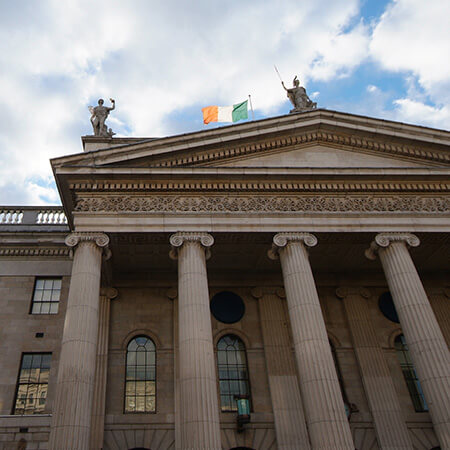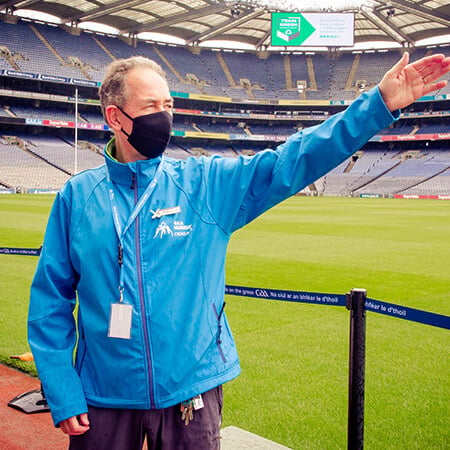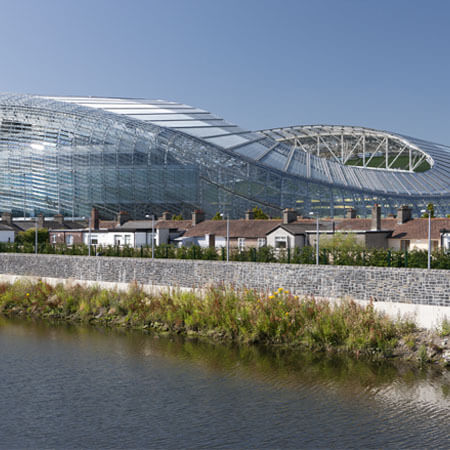Croke Park. It’s not just a stadium.
As Tim Carey, author of Croke Park: A History says: “More than perhaps any other sporting venue, Croke Park represents something that is beyond sport”.
The stadium is the home of Gaelic games in Dublin, but it has always had a deeper importance – one that’s intimately connected with the birth and evolution of the Irish nation.
“It is freighted with historical significance,” says Carey. “From the naming of the stands after various figures associated with the GAA to the momentous historical event of Bloody Sunday. Perhaps, no other stadium in the world occupies such a central place in a nation’s psyche.”
And perhaps no other stadium tells stories that are so in tune with the needs of that psyche. One of the most important stories is that of Croke Park’s Hill 16.
The history of Hill 16
Hill 16 is the spiritual home of the Dubs’ supporters and, looking back, it’s easy to understand why.
The terrace was first constructed in 1917 to give spectators a better view of the pitch and, until the 1930s, it was called Hill 60. Why the name change, you might wonder? What happened to the missing 44?
Remembering Irish soldiers in the British army
The original Hill 60 was the site of a bloody encounter between the 5th Battalion of the Connaught Rangers and the Turkish army in Gallipoli in August 1915.

Officers of the 5th Connaught Rangers outside a house in Tatarli, Turkey, in 1915
The Connaught Rangers was an Irish regiment of the British army and its 5th Battalion had been raised in Dublin the previous year.
Reports of the battalion’s progress and eventual retreat were carried in the Dublin newspapers on a daily basis. In one week, The Connaught Rangers sustained 198 casualties, including 90 deaths.
At the same time, work was underway to raise the level of one of the terraces at Croke Park. Dublin ironists couldn’t resist the temptation of calling this new ‘hill’ after the famous one in Gallipoli. Its name remained Hill 60 until the 1930s.
An assertion of Ireland’s newfound independence
At this stage, the newly independent state decided it was time to rename the terrace. Instead of a name that highlighted Ireland’s time as part of the British Empire, it wanted pay tribute to its own unique history.
So it was decided that the number 16 – the year of the Easter Rising – would be a more appropriate name for a terrace in the stadium which played a role in forging Ireland’s national identity.

Remains of a hotel on Sackville Street, now O’Connell Street, after the 1916 Easter Rising
The renaming of Dublin’s streets was well under way by this time. Even before Irish independence in 1922, Dublin Corporation had begun removing references to colonial rule and replacing them with nods to the country’s nationalist history.
Considering Croke Park was the location of the Bloody Sunday massacre – when British forces opened fire on civilians at a Gaelic football match – many saw the renaming of Hill 60 as an important step. It’s also worth noting that Croke Park’s Hogan Stand, which was built in 1924, is named after Tipperary player Michael Hogan who was one of 14 people who died in the stadium that day.
Interestingly, according to Britain’s National Army Museum, two of the Connaught Rangers’ reserve battalions fought against the rebels of the Easter Rising, which makes the name change even more poignant.
The creation of a enduring myth
It was also around the 1930s that fictional tales of Hill 16 began to circulate.
Disappointingly, the story that Hill 16 was built on the rubble of the Rising – delivered by handcart from O’Connell Street – is another example of myth-making. Work on the Hill was actually already complete by the time of the 1915 All-Ireland finals.
This is just a story born of the rivalry between a newly emergent nation and an old empire. It’s a rivalry that’s embedded in the Irish psyche and one that has cemented Hill 16 into the consciousness of the nation.
But that same psyche has got plenty of room for inter-county rivalries too.
Great GAA rivalries
Sure, we all get along well with each other most of the time. We can share a pint and exchange banter before the match. Or after the match. However, once you step through the turnstiles into Croke Park, all bets are off.
There are the great rivalries, of course: Cork and Kerry, Kilkenny and Tipperary, Donegal and Tyrone. One of the oldest is that of Dublin versus Kerry. The two counties have faced each other in the All-Ireland football finals 13 times since it began in 1888. The two first met in the finals back in 1892 and they both have far more all-Ireland wins than any other counties.
A strong rivalry between Dublin and Mayo is also brewing. Though the two teams have only faced each other in the championship finals five times, four of those meetings have occurred in the past decade.
Hill 16: The home of the Dubs
Over the years, the Dubs have adopted Hill 16 as their own. I’ll never forget standing there on the day of the All-Ireland Semi-Final 2006. Mayo ran out first and warmed up in front of The Hill. This may sound innocent enough on the face of it, but it flouted an unwritten rule: it’s The Dubs who warm-up in front of Hill 16.




